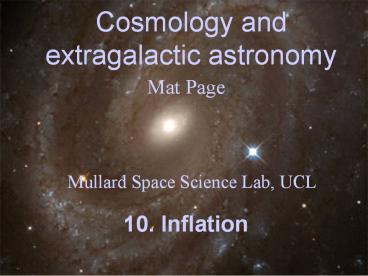Cosmology and extragalactic astronomy - PowerPoint PPT Presentation
1 / 27
Title:
Cosmology and extragalactic astronomy
Description:
Cosmology and extragalactic astronomy Mat Page Mullard Space Science Lab, UCL 10. Inflation You are the result of a quantum fluctuation! Galaxies, Planets, You 11. – PowerPoint PPT presentation
Number of Views:181
Avg rating:3.0/5.0
Title: Cosmology and extragalactic astronomy
1
Cosmology and extragalactic astronomy
Mat Page
Mullard Space Science Lab, UCL
10. Inflation
2
- You are the result of a quantum fluctuation!
3
Galaxies, Planets, You
4
(No Transcript)
5
11. Inflation
Slide 2
- This lecture
- Problems with the standard big bang
- What is inflation?
- How does it work?
- How does it solve the problems?
- Different inflation models
6
Problems with the standard Big Bang
Slide 3
- The horizon problem
- large scale structure
- flatness
- the monopole problem
7
The horizon problem
Slide 4
- Light from the CMB is just reaching us.
- Regions of the CMB in opposite directions are not
in causal contact - How come they are at the same temperature?
- In fact, regions of the CMB separated by more
than 2o are causally disconnected!
8
(No Transcript)
9
The horizon problem
Slide 5
10
Large-scale structure
Slide 6
- How come galaxies exist?
- Big Bang is isotropic and homogeneous, but
- galaxies, clusters, superclusters
- CMB anisotropies
- So anisotropy has existed since decoupling at
least, but how did it get there?
11
Flatness
Slide 7
- Observationally we have W0 1.02 -0.02 but look
how W evolves with time in Friedmann models - Matter dominated W(t)-1 a t2/3
- Radiation dominated W(t)-1 a t
- So for W1.02 now we need W110-5 at
decoupling, and very much closer to 1 at the
Planck time. - This is a fine-tuning problem why should the
Universe just happen to be flat?
12
The monopole problem
Slide 8
- Fundamental forces were unified in the early
Universe - As time progresses, forces decouple
- phase transition in the Universe
- Many theories predict topological defects
- Domain walls
- Strings
- Magnetic monopoles
- Monopoles most common in theories - some
calculate more monopoles than matter. - But we havent seen any!
13
- Can solve ALL these problems in one go by having
a very rapid (exponential) early expansion
inflation
14
Inflation explains the horizon problem
Slide 9
- Many different inflation models, but all have
rapid expansion in early Universe
15
Inflation explains the structure problem
Slide 10
- In the early Universe, we expect quantum
fluctuations both in space-time itself and in the
density of fields in space - Rapid inflation expands these fluctuations vastly
in size, and moves them out of causal contact
with each other. - No causal contact, so the fluctuations cant
thermalise - they are frozen in. - Suddenly we have large scale anisotropies, and so
structures can form.
16
Quantum fluctuations and cosmic structure
17
Inflation solves the flatness problem
Slide 11
- Consider a Universe undergoing a rapid period of
inflation. - Universe expands, becomes locally flat.
- We dont notice the Earths curvature as we walk
around. - Solves the fine tuning problem - start with any
curvature, and inflation will dilute it to 1.
18
Inflation explains the monopole problem
Slide 12
- At the time of inflation, we predict 1 monopole
per particle horizon. - With standard Friedmann cosmology, wed now have
in excess of 10100 monopoles in the observable
Universe. - With inflation, all our observable Universe was
in causal contact at early times, so we expect
one monopole in the observable Universe - Not only does inflation dilute curvature, it
dilutes monopoles and other space-time defects
too.
19
What drives inflation?
Slide 13
- We invent a new scalar field called the
inflaton - motivated by symmetry breaking in particle
physics - inflaton can be identified with one of the
particle physics symmetry breakings but need not
be.
20
Inflation how it works
Slide 14
- The Inflaton has a constant and negative pressure
- Exponential runaway effect
21
Inflation how it works
Slide 14
- Above Tc we have a normal universe
- At Tc a lower energy state becomes available
- Universe now is in state analagous to a
supercooled liquid. - False vacuum acts like pressure
- rapid expansion
22
Inflation how it works
Slide 15
- Some time later, expectation value of inflation
finds minimum. - Rapid phase transition, like supercool liquid
freezing - Inflation stops
- Lots of free energy
- Energy causes reheating of what is now basically
empty space - Lots of energy -gt matter forms
- And there was a universe
- Normal expansion continues
23
Inflation models
Slide 16
- Old inflation
- New inflation
- Chaotic inflation
24
Old inflation
Slide 17
- Alan Guth, 1981
- First order phase transition (bubble nucleation)
- Bubbles too small to be our universe - visible
universe would not be uniform enough.
25
New inflation
Slide 18
- Linde, Albrecht, Steinhardt 1982
- Second order phase transition (domains, like a
ferromagnet) - Need fine tuning to get enough inflation
26
Chaotic inflation
Slide 19
- Linde, 1981
- Inflation happens everywhere
- Different parts of Universe have different f, so
inflate differently at different times. - Produce local regions of homogeneous isotropic
universe, but on a larger (than observable)
scale, universe is highly curved, inhomogeneous - Many universes - some can have life
- Thats where we are according to the anthropic
cosmological principle.
27
Key points
Slide 20
- Standard Big Bang theory has problems with fine
tuning and causality - Inflation solves these problems
- causality solved by observable universe having
grown rapidly from a small region in causal
contact - fine tuning problems solved by the diluting
effect of inflation - many different models of inflation
- some kind of inflation appears to be required,
but the exact model not decided on yet.































